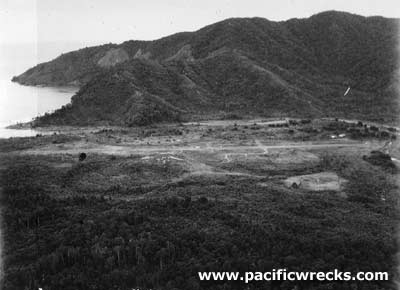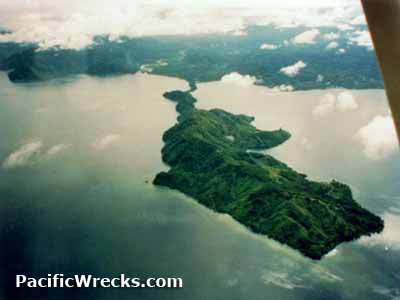|
|
|
|
| Missing In Action (MIA) | Prisoners Of War (POW) | Unexploded Ordnance (UXO) |
| Chronology | Locations | Aircraft | Ships | Submit Info | How You Can Help | Donate |
|
 Prewar  USN March 10, 1942  5th AF May 21, 1943  5th AF March 20, 1944  Richard Leahy 1996 |
Location Salamaua Airfield is located near Logui on the mainland of New Guinea. The wartime era name, Logui Airfield or Logui Strip No. 2 or Lugui #2 referenced the two nearby villages. To the south is mouth of the Francisco River at Kennedy's Crossing. Salamaua is located to the northeast and Bayern Bay is to the east. The single runway runs roughly northeast to southwest along Bayern Bay to the southwest of Salamaua. Prewar located in the Territory of New Guinea. Today located in Salamaua Rural LLG, Morobe Province in Papua New Guinea (PNG). Construction Built prewar by the Australians to support gold mining operations inland. The single runway borders Bayern Bay to the northeast and to the southwest borders the Francisco River. Wartime History On January 21, 1942 at 11:55am Japanese planes bombed Salamaua Airfield. Destroyed on the ground were three civilian DH.84 Dragons, one RAAF Hudson. While taxing, a DH.84 Dragon piloted by Kevin Parer was killed. Dring the air raid, a Junkers G 31 trimotor approached Salamaua Airfield but was able to escape the area and diverted to land at Wau Airfield instead. On January 22, 1942 the few defending Australians abandoned Salamaua fearing further air attacks, leaving the area undefended. In early March 1942, Australian Army Captain Allan Cameron arrived at Salamaua to defend the area and stationed himself at Salamaua Airfield. On March 8, 1942 before dawn, the Japanese Army, South Seas Force, 144th Battalion under the command of Major Tadashi Hori made an amphibious landing at Salamaua. Captain Cameron ordered a RAAF Hudson piloted FO Alfred Hermes to take off then ordered the fuel dump demolished and their radio destroyed. In the predawn darkness, as the Japanese approached they opened fire on the Australians who were attempting to demolish the runway with explosive charges but due to rain, the explosives failed to ignite. The remaining defenders gave up and fled across the Francisco River to escape. Afterwards, the Japanese upgraded Salamaua Airfield for military use and used it to a limited capacity. Between the middle of 1942 until early September 1943 Salamaua Airfield was targeted by Allied bombers and fighters. Japanese and American missions against Salamaua Airfield January 21, 1942–September 12, 1943 On September 11, 1943 the Australian Army 5th Division occupied Salamaua Airfield. The following day, the first Allied plane landed but the airfield was never heavily used by the Allies. Today Disused since the Pacific War. Phil Bradley reports: "The airstrip was knee deep in water in June when I visited." References The Battle For Wau (2008) page 2 New Guinea Volunteer Rifles (NGVR) records show that on the 21st January 1942 the surprise attack on Salamaua by Japanese fighters and bombers destroyed one RAAF Lockheed Hudson, 2 De Havillands and 2 Fox Moths. Hell's Battlefield (2012) pages 24-26 Contribute
Information Last Updated
|
Map 1942 Map 1943 View in Google Earth Photo Archive |
| Discussion Forum | Daily Updates | Reviews | Museums | Interviews & Oral Histories |
|